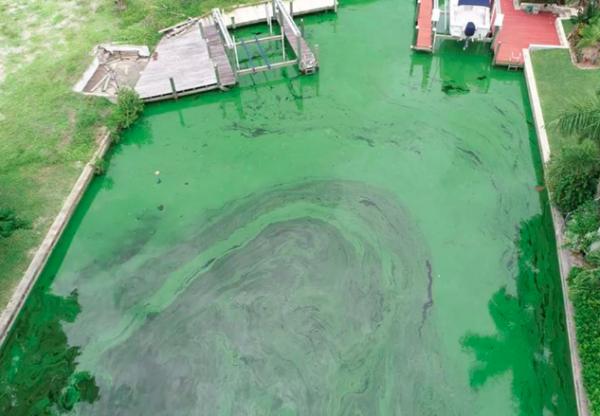There is a real mess going on in Southern Florida. Lake Okeechobee, which is the second largest body of fresh water in the US, as well as other waterways, are being overrun by a massive bloom of blue-green algae. This bloom is threatening both tourism and health. The science here is especially interesting, partly because blue-green algae, are not algae; they are bacteria, capable of serving up some of the world's most toxic chemicals.
Although cyanobacteria, which can fix nitrogen and perform photosynthesis, play an important part in the earth's ecosystem, when blooms form, especially usually when the water is still, polluted, or warm, a substantial amount of a variety of neurotoxins is produced. Neurotoxins are not to be taken lightly.

Cyanobacteria, Image: Wikipedia
Here are three representative neurotoxins produced by blue-green algae. They all operate by different mechanisms and are all quite deadly central nervous system poisons.
- Anatoxin-a, (Figure 1, left) which also goes by the rather disquieting name of Very Fast Death Factor (VFDF), was the first cyanotoxin to be isolated and identified in 1972. Despite its very simple chemical structure, it packs quite a punch. VFDF is a powerful neurotoxin because it binds very tightly - more so than the natural neurotransmitter acetylcholine - to the nicotinic acetylcholine receptor (Figure 1, right) in the neural synapse.

Figure 1. (Left) The chemical structure of anatoxin-a. (Right) A schematic drawing of the nicotinic acetylcholine receptor in the neural synapse. (Source: Open Access Maritime Drugs 2014, 12(5), 2970-3004.)
Worse still, while levels of acetylcholine in the synapse are controlled by the enzyme acetylcholinesterase, which metabolizes it, VFDF is not metabolized by this enzyme and stays in the synapse causing the nerve to fire non-stop. Since the function of nicotinic acetylcholine receptors is to send on-off signals that control muscle contraction, it is not surprising that the symptoms of toxicity include:
- Loss of muscle coordination
- Muscle tremors
- Convulsions
- Paralysis
- Respiratory distress
Death from respiratory failure typically occurs within 2-7 minutes.
- Lyngbyatoxin-a (Figure 2, Left) is a chemical defense weapon produced by certain strains of cyanobacteria as a defense against predatory fish. Its toxicity is very different from that of anatoxin-a:
- A potent skin irritant and a vesicant (causes blisters). It causes "seaweed dermatitis" (Figure 2, Right).
- Severe gastrointestinal damage when consumed, which can be fatal.
- It is both a carcinogen and tumor promoter.
. 
Figure 2. (Left) The chemical structure of lyngbyatoxin-a (Right) Seaweed dermatitis caused by lyngbyatoxin-a.
(Source: DermNet NZ)
- Saxitoxin
Saxitoxin (1) is also known as Paralytic Shellfish Poison (PSP). Outbreaks of PSP are not uncommon in warm weather. In addition to South Florida, there have been recent cases on Vancouver Island, Long Island, and San Francisco.
Saxitoxin binds to voltage-gated sodium channels (Figure 3), also called ion channels - a large and diverse family of transmembrane proteins that regulate the flow of sodium (Na+) and potassium (K+) in and out of cells.
Figure 3. (Left) The chemical structure of saxitoxin. (Right) Schematic drawing of a voltage-gated ion channel (Source: Google Sites)
Transmembrane proteins can be thought of as gates; when the gate is closed ions cannot enter or exit cells and when it is open they can. This flux of sodium and potassium ions into and out of cells - it can be thought of as a molecular switch - is a fundamental mechanism that regulates nerve function. So not surprisingly when this mechanism is perturbed very bad things happen. This is reflected in some of the symptoms of PSP:
- Tingling
- Vomiting
- Diarrhea
- Abdominal cramps
- Headache
- Dizziness,
- Muscle weakness
- Disorientation
- Memory loss
- Loss of coordination
And in serious cases:
- Seizures
- Unstable blood pressure
- Paralysis
- Difficulty breathing,
- Coma
- Death
Blue-green may be a very pretty color when it's the clear water of the Caribbean but not so much when it's an odorous scummy collection of billions of bacteria.
NOTES:
(1) Saxitoxin is not a single chemical compound; it is a family of 50 structurally related chemical compounds called tricyclic guanidium alkaloids.




